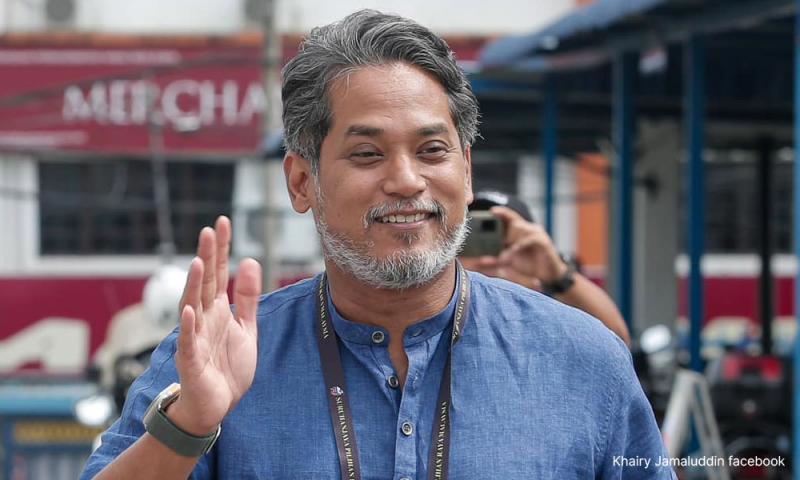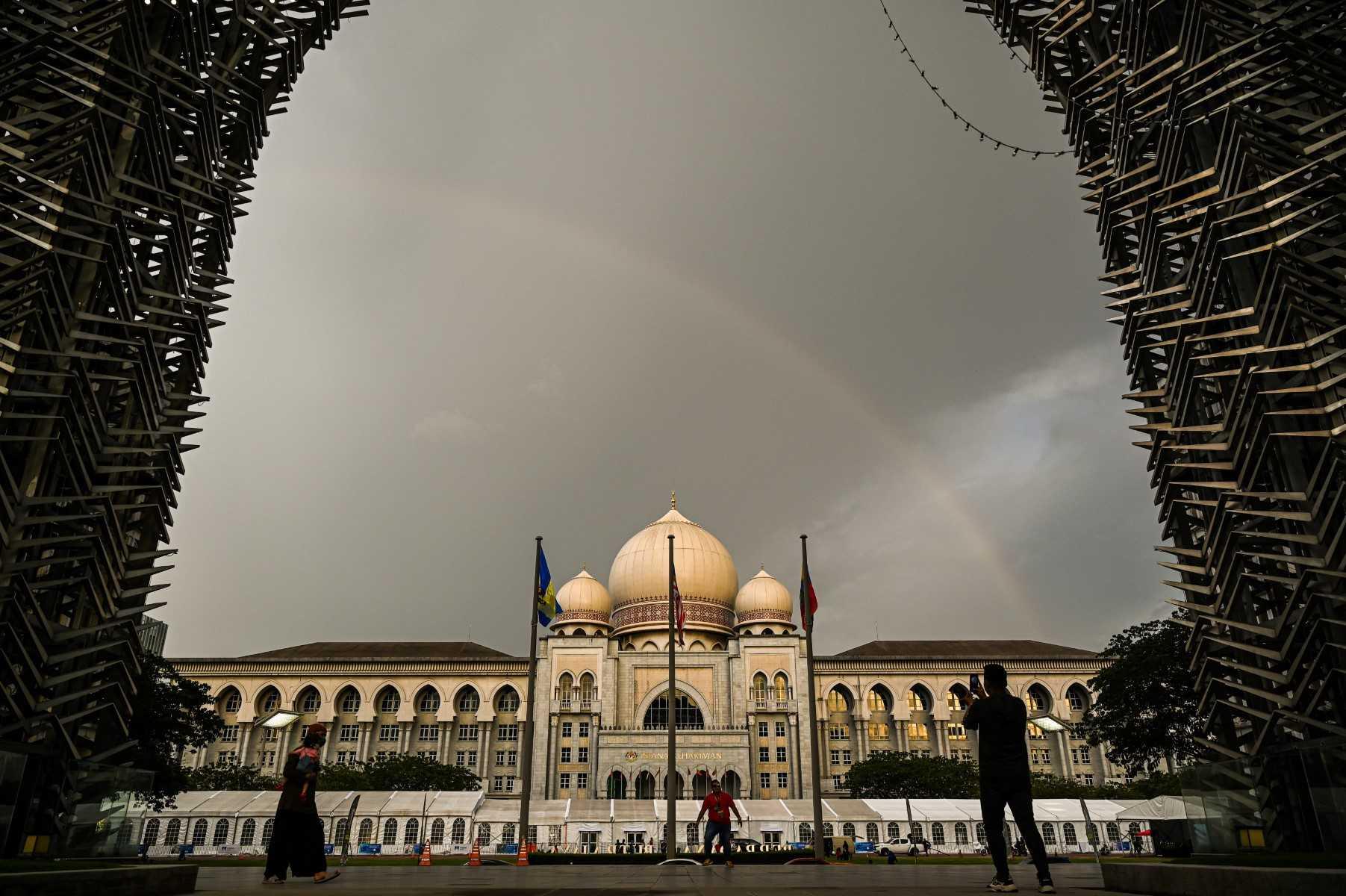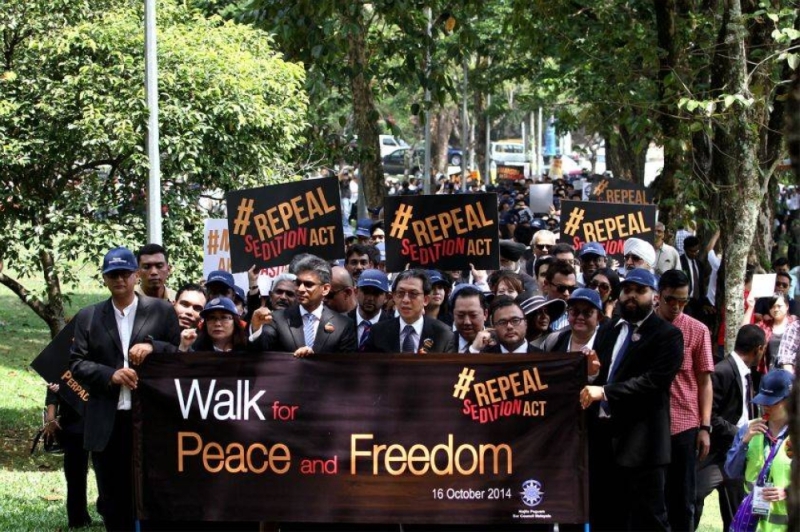I believe that for the first time UMNO has barred contest for its top 2 post using a Resolution passed at the General Meeting.
First time that potential contenders for top positions have been sacked or 'suspended' before elections. But Khairy, Hishamuddin, etc still can appeal to the Disciplinary Board, and if still disatisfied can appeal to 'Majlis Kerja Tertinggi'(which seems to be different from the General Meeting). If they do appeal, would they still be able to exercise all memberships, including the right to contest in the upcoming UMNO elections, until they exhausted all avenues of appeal. Najib was able to function as MP until the Federal Court dismissed his final appeal. Logically, Khairy and Hishamuddin despite the first disciplinary decision, should be able to still contest pending the dispossal of their appeals..
20.6 Seseorang ahli atau pihak yang tidak berpuas hati dengan tindakan disiplin yang dikenakan oleh Jawatankuasa Disiplin, hendaklah merayu kepada Lembaga Disiplin terlebih dahulu sebelum rayuan terakhir itu dibawa ke peringkat Majlis Kerja Tertinggi untuk keputusan muktamad
It was common in the past for General Meetings and members to generally express similar sentiments in the past- but never before, I believe, a TOTAL denial of the right of a member to contest the top 2 positions through a Resolution.
If such a thing is possible, then there can be similar resolution that maintain the position of ALL incumbent leaders, not just at national level but also division and branch levels can eliminate most elections. There will only be elections if the incumbent decides to step aside and no longer contest OR dies. That sounds very much like FEUDALISM and not democracy.
Any society, even UMNO, can decide - i.e. its members can decide whether it wants to be democratic or something else.
In 2023, UMNO members still do not have the right to individually vote who will be their President and national leadership. PKR stands out here in that every member has the right to vote the President and national leadership.
UMNO has a 'delegate system' where the right to participate in national General Meetings and make decisions therein is with the delegates - same too the right to vote and choose the President and the national leadership.
8.4 Perhimpunan Agung Tahunan hendaklah terdiri daripada:-
8.4.1 Pengerusi Tetap dan Timbalan Pengerusi Tetap.
8.4.2 Ahli-ahli Majlis Kerja Tertinggi.8.4.3 Wakil yang dipilih oleh Perwakilan Tahunan Bahagian sebanyak seorang wakil bagi tiap-tiap lima ratus (500) orang ahli dengan syarat bilangan wakil-wakil itu tidak lebih daripada tujuh (7) orang dari satu Bahagian termasuk Bahagian yang Jawatankuasanya sedang digantung jika Bahagian itu boleh mengadakan Perwakilan Bahagian dengan sempurna.8.4.5 Tidak lebih daripada sepuluh (10) orang wakil Wanita UMNO, sepuluh(10) orang wakil Pergerakan Pemuda dan sepuluh (10) orang wakil Pergerakan Puteri yang dipilih oleh Perhimpunan Agung Pergerakan masing-masing.
8.4.4 Ketua, Timbalan Ketua, Naib Ketua, Ketua Wanita UMNO, Ketua Pergerakan Pemuda, Ketua Pergerakan Puteri dan Setiausaha Bahagian yang telah mengadakan Perwakilan Bahagiannya. Mereka di atas yang menjadi Ahli Majlis Kerja Tertinggi berhak melantik gantinya yang terdiri daripada Pengerusi Tetap, Timbalan Pengerusi Tetap atau Ahli Jawatankuasa Bahagian.
DELEGATES represent the specific groups of UMNO members - so, in the voting of motions and passing Resolutions, are these 'delegates' voting as per what the members for whom they are delegates for wants and decided, OR did they simply decide as they please without any reference and mandate for the members they represent.
I did not read media reports about UMNO branch or division meetings being called to discuss on whether to support or not the Motion(now resolution) deciding no contest for the top 2 national leadership positions? Some say the motion came about at the last minute - so there was no time to revert back to the members, and so these 'delegates' had to decide then and then on their own. So, it may not be what the UMNO members really wanted.
If UMNO had had its General Elections before end June 2021, the likelihood of Zahid Hamidi and many of the current leaders in UMNO was slim. When Zahid won in 2018 UMNO elections, it was before he was charged in court.
In the 2018 Umno elections, Zahid obtained 99 votes while Khairy Jamaluddin received 61 votes and Tengku Razaleigh Hamzah 30 votes.
However, Zahid's biggest challenger is no more, as Khairy has just been sacked....?
Note that Zahid and the UMNO No. 2 could have spoken up for elections opposing the motion that the top 2 post not be contested. If they did, then the General Meeting may not have voted and passed that Resolution.
Zahid's victory in 2018 happens before the High Court made a decision that the prosecution had established prima facie case, and Zahid had been ordered to enter his defence.
The High Court has ordered former deputy prime minister Ahmad Zahid Hamidi to enter his defence on all 47 of his corruption, criminal breach of trust (CBT) and money laundering charges. Judge Collin Lawrence Sequerah ruled that the prosecution had established a prima facie case against Zahid. - FMT, 24/1/2022
The question has been raised as to whether PM Anwar Ibrahim advised the King on the making of Judge Collin Lawrence Sequerah a Court of Appeal judge as per recommendation of the Judicial Appointments Commission(JAC) - or whether Anwar ignored the JAC's recommendation. see Amend Federal Constitution and Judicial Appointments Commission Act 2009 to remove Prime Minister’s role in appointment and elevation of judges in Malaysia. PM must disclose whether recent appointments is as per recommendation of the Judicial Appointments Commission or not. (MADPET)
There has been growing sentiments amongst some in UMNO, to clean up UMNO and remove the so-called 'Court Cluster'
October 2018 - Former Malaysian deputy prime minister Ahmad Zahid Hamidi claimed trial on Friday to 45 charges of criminal breach of trust, abuse of power and money laundering involving some RM114 million (S$37.8 million).
On 18/12/2018, Zahid went on 'garden leave' as President of UMNO, 'Zahid announced that his deputy Mohamad Hasan will now assume the duties of Umno president."In light of the crisis faced by the party today, I have decided to entrust the deputy president with the duties of the Umno president....' -Malaysiakini, 18/12/2018
30/6/2019 - Zahid assumed all duties of UMNO President
27/6/2019 - Former deputy prime minister Datuk Seri Ahmad Zahid Hamidi was slapped with another 33 charges at the Sessions Court here today for receiving bribes totalling RM42.7 million, as an inducement to extend the contract of Ultra Kirana Sdn Bhd in managing the One Stop Centre (OSC) in China and the Visa Luar Negara (VLN) system. - On Sept 23, then High Court judge Yazid Mustafa ruled that the prosecution had failed to establish a prima facie case against Zahid.
The prosecution has filed its petition of appeal to challenge Ahmad Zahid Hamidi’s acquittal from 40 charges of corruption purportedly given by a company to secure the extension of a contract to operate a foreign visa (VLN) system and a one-stop centre in China. - FMT, 29/12/2022
UMNO President Zahid Hamidi and Supreme Council 3 year term ended on 30 June 2021, and there should have been a party election to determine who will the new President, Supreme Council members and leaders of the party. If there was party election, UMNO members may have chosen other leaders. UMNO without elections may have been declared illegal and de-registered. But, then 'mysteriously' the Registar of Society, not UMNO members, decided to delay elections until end 2022.NO Democracy in UMNO? State elections, but still UMNO delays elections - kept Zahid Hamidi in power beyond 3-year term? UMNO members Ok with this?
Then in March 2022, The Umno General Assembly has approved a motion to postpone the party election to six months after the 15th General Election (GE15) is held, says Umno Deputy President Datuk Seri Mohamad Hasan.
This meant Zahid Hamidi and the National leadership were able to decide on UMNO candidates in GE15 - this power of national party leadership power in determining the party's candidate for State and Federal elections is common amongst parties in Malaysia - something that I believe should change.
Now, with UMNO's no challenge to top 2 positions may mean that Zahid Hamidi and Mohamad Hasan will remain President and Deputy for another 3 year term.
The sacking or 6-year suspension of potential challenger/s before the party elections means Zahid Hamidi and Mohamad Hasan's position may be safe. Even if the Registrar of Society decides not to approve the no-challenge resolution, the potential threats in Khairy and Hishamuddin may have been removed. They may no longer be qualified to contest for the Presidency or Deputy Presidency of UMNO.
Come end June 2023, Zahid would have been President of UMNO for 5 years. Note the term of office as per the UMNO constitution is just 3 years.
Now, the delegates at the UMNO General Assembly that adopted the no challenge Resolution, how many of them were holding their position beyond the 3 year term? How many would have retained their position if elections were held before June 2021?
UMNO Constitution talks about 'Perwakilan Tahunan Bahagian' - was there a recent annual elections that picked the Delegates that were at the said General Meeting?
UMNO's membership - after GE in 2018, we saw a lot of MPs/ADUNs leaving UMNO to join other parties. Reasonably, when these 'party leaders' left - members will also follow. So how many members do UMNO still have? Remember the number of delegates per division depends on membership numbers... As such, membership decline determines the number of delegates.
As it is, any society's affairs ought to determined by ALL its members, but can any member be denied the ability to participate in the decision making process of a society - especially in the amendment of constitution, passing of Resolution and voting of leadership.
Some clauses from the UMNO constitution of interest:-20.6 Seseorang ahli atau pihak yang tidak berpuas hati dengan tindakan disiplin yang dikenakan oleh Jawatankuasa Disiplin, hendaklah merayu kepada Lembaga Disiplin terlebih dahulu sebelum rayuan terakhir itu dibawa ke peringkat Majlis Kerja Tertinggi untuk keputusan muktamad
20.7 Seseorang ahli yang membawa apa-apa jua perkara parti atau hak keahliannya ke mahkamah sebelum mematuhi sepenuhnya peraturan-peraturan parti maka keahliannya di dalam parti gugur dengan sendirinya.
20.12 Ahli-ahli yang dikenakan hukuman, boleh membuat rayuan supaya:
20.12.1 Menarik balik penggantungan keahliannya selepas dua (2) tahun daripada tarikh ia dihukum.
20.12.2 Menarik balik pemecatan keahliannya selepas tiga (3) tahun daripada tarikh ia dihukum.
20.12.3 Menarik balik pengguguran keahliannya dari tarikh keahliannya gugur.
# The above are just my opinion and views...it is an interesting matters of interest to all Malaysians. If Zahid was challenged, and lost his Presidency - there would be consequences - as we may have a new Deputy Prime Minister...mmmm
Ahmad Zahid Hamidi has announced his return from garden leave to resume the mantle of Umno president.
Zahid made the announcement in conjunction with the first anniversary of him being elected as party president and not "appointed by Umno" leadership.
"So the one year is significant and important to me, hence on June 30, 2019, I wish to announce that I am ending my (garden) leave today.
“This means, beginning today, I will resume my role as Umno president,” he said during a Hari Raya event in Perak.
Zahid went on leave in December last year amid pressure for him to step aside.
His opponents from within Umno had criticised him for what they claimed was a lack of direction.
Zahid also presided over an exodus of lawmakers from the party, with threats of further defection if he did not step down.
He finally relented, and on Dec 18 announced that his deputy Mohamad Hasan (left in photo) would take over as the new acting president.
Zahid's return just six months later threatens to reopen faultlines in the party.
Just hours ago, former Umno Youth chief Khairy Jamaluddin – a close ally of Mohamad – had said Zahid should first seek the opinion of the Umno supreme council before announcing his return.
"Morally, it should be discussed by the Umno supreme council. Zahid was on leave and the supreme council carried out his duties so it would be unfair if the supreme council is not consulted.
"To say that it is solely Zahid's decision, I would disagree.
"In the last few months, including the three by-election wins we achieved, they were all done under Tok Mat (Mohamad)," he said after officiating the Sungai Buloh Umno divisional meeting in Shah Alam today. Yesterday, former Umno president Najib Abdul Razak had said it was up to Zahid to decide whether he should make a comeback.
Both Najib and Zahid are facing graft charges.
Under Mohamad, a proposal was made to expel Umno members convicted of graft and who have exhausted all appeals.
However, the proposal was shot down with strong objection from the likes of Umno supreme council member Lokman Noor Adam, a Najib loyalist.
In an immediate response, Sabah Umno chief Bung Moktar Radin hailed Zahid's return.
"Zahid's announcement to end his leave is a good move, in line with the mandate given to him as president. As a leader and party member, we should respect it.
"Sabah Umno is confident that the party's mission and
mobilisation will be intensified with this decision. Let us strengthen
the party together," he said in a statement. - Malaysiakini, 1/7/2022

News
KJ sacked, Hishammuddin suspended
B Nantha Kumar
Published: Jan 27, 2023 10:55 PM
⋅
Updated: 11:41 PM
Umno presidential hopeful Khairy Jamaluddin has been sacked by the party.
Earlier, the party had also sacked supreme council member Noh Omar, who asked to be let go after he was suspended for six years.
Umno secretary-general Ahmad Maslan announced in a statement that they were axed for breaching party discipline during the 15th general election.
However, the specifics of their offences were not mentioned.
Khairy had wanted to challenge Umno president Ahmad Zahid Hamidi for control of the party.
He had also alleged there were "phantom delegates" planted at the Umno annual general assembly (AGM) in order to pass a motion that would bar contest for the party’s presidency and deputy presidency. Umno secretary-general Ahmad Maslan
Umno secretary-general Ahmad Maslan
Khairy had said yesterday that he would remain loyal to Umno and rejected overtures for him to join Perikatan Nasional.
Meanwhile, Ahmad said the party has also sacked 26 Pahang Umno members, as well as five from the Pasir Gudang division, Putrajaya division (9) and Tanjung Karang (2).
Several others have been suspended for six years including Sembrong MP Hishammuddin Hussein and incumbent deputy Umno Youth chief Shahril Hamdan Suffian. Sembrong MP Hishammuddin Hussein
Sembrong MP Hishammuddin Hussein
Also suspended were former Jempol MP Salim Sharif and former Tiram assemblyperson Maulizan Bujang.
The reason for their suspension was not stated.
Earlier, Umno supreme council member Puad Zarkashi said in a Facebook post that fellow council member Fathul Bari Mat Jahya had also been suspended.
READ MORE: Umno axes Noh Omar: He opts for sacking instead of 6 year suspension
However, Fathul was not among those that Ahmad declared had been suspended in the official party statement.
The sackings and suspensions were meted out following a supreme council meeting on Friday night, with Ahmad saying that the party had acted on the recommendations from its disciplinary board.
On a related matter, the party also announced that Umno vice-president Khaled Nordin will be the new Johor Umno chief, replacing former menteri besar Hasni Mohammad. - Malaysiakini, 27/1/2023
Umno leaves it to RoS to decide validity of the no-contest decision

BAGAN DATUK: Umno will leave it to the Registry of Societies (RoS) to decide the validity of the party's general assembly decision not to hold contests for the top two party positions.
Its president Datuk Seri Dr Ahmad Zahid Hamidi insisted that everything done during the 2022 Umno General Assembly, which concluded on Jan 14, was in accordance with the constitution of the party.
He, however, admitted that there is a clause in the Societies Act 1966, which stated that RoS must be made aware of the decision passed during the party's general assembly.
"In my opinion, the matter is not about obtaining approval but rather informing the RoS.
"The meeting (the party's general assembly) proceeded according to the Umno Constitution and the party's permanent chairman followed all the necessary procedures," he told reporters after visiting the construction site of the Bagan Datuk - Kampung Sejagop bridge here today.
Zahid, who is the deputy prime minister and minister in-charge of rural and regional development, was asked to comment on the complaints lodged with the RoS over the "no contest" resolution moved for the top two party posts at the 2022 Umno General Assembly.
The complaints were filed by Muhammad Aizat Fikri Mohd Nasir and Muhammad Fiqri Firdaus Muhammad Rom, who are Umno members from Terengganu and Negri Sembilan respectively. They submitted the complaints to Ros in Putrajaya on Friday.
When asked on the actions of the two members, Zahid said Umno is a party that is very open about the matter.
"If there are any reports or complaints lodged with the RoS, Umno is open for the members to submit the report," he said.
Zahid nevertheless hopes that RoS will accept the motion passed during the recent Umno General Assembly as a valid decision.
The decision by RoS, he said, could also put to rest any speculation over the party's decision not to contest the posts of party president and deputy president in the upcoming Umno election.
"I leave the matter to the party delegates (who attended the Umno General Assembly) to decide and they have made their decision (over the motion for no contest for the top two positions in the party).
"What is important is to defend and protect unity in the Umno leadership," he said.
The Umno General Assembly at the Kuala Lumpur World Trade Centre last week approved an additional motion for the posts of president and deputy president to remain unchallenged in the party election.
The additional motion was proposed by Rembau Umno delegate Mohd Shukri Shamsudin during the debate on the president's policy speech and was seconded by Marang Umno chief Datuk Nik Dir Nik Wan Ku.

 14
14  Justices Abang Iskandar Abang Hashim (left) and Zabidin Diah have been performing the functions of their new positions since November.
Justices Abang Iskandar Abang Hashim (left) and Zabidin Diah have been performing the functions of their new positions since November.  166
166  81
81  32
32 






